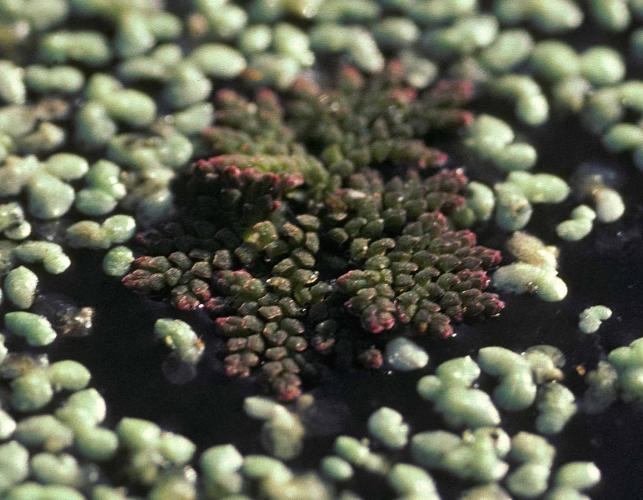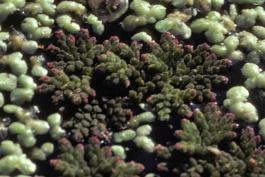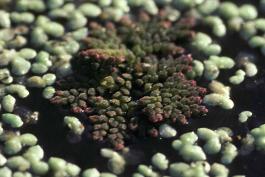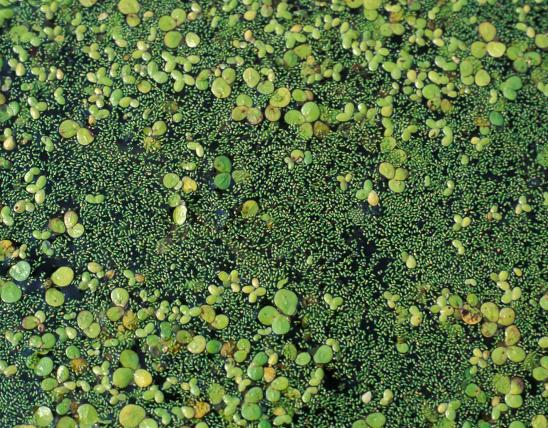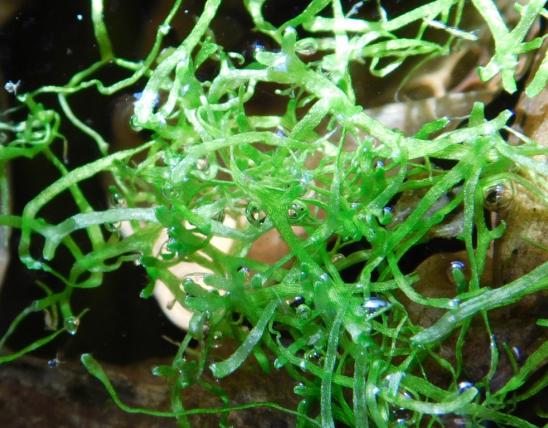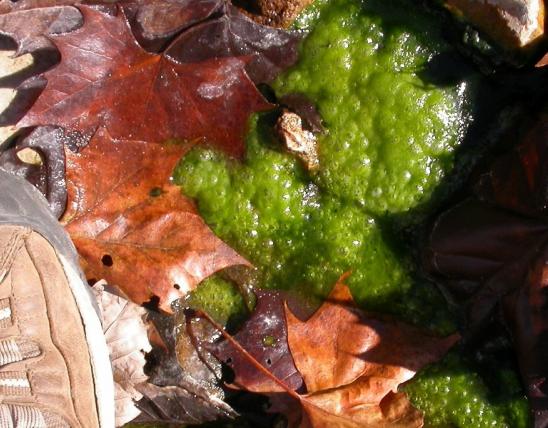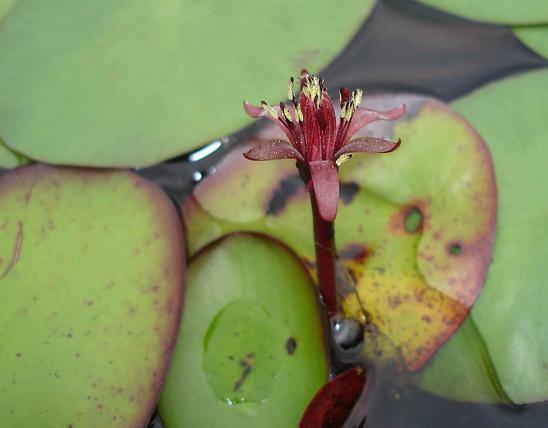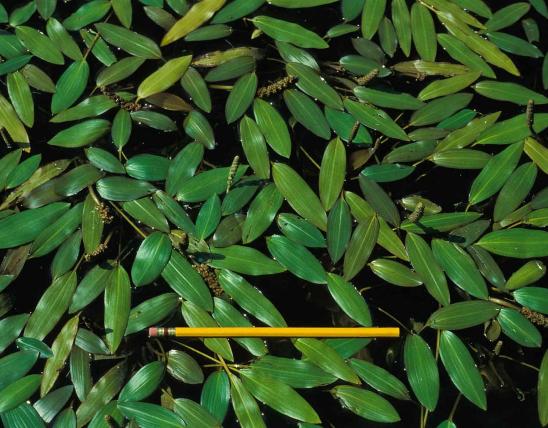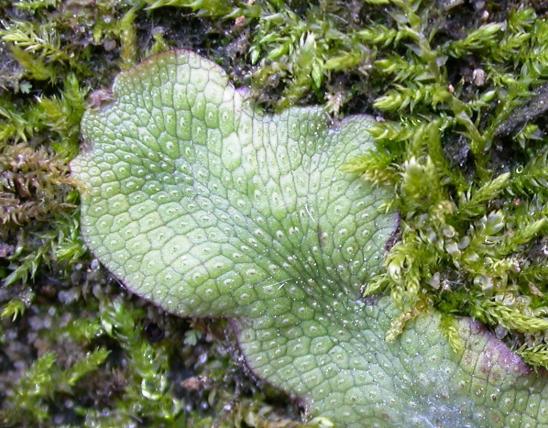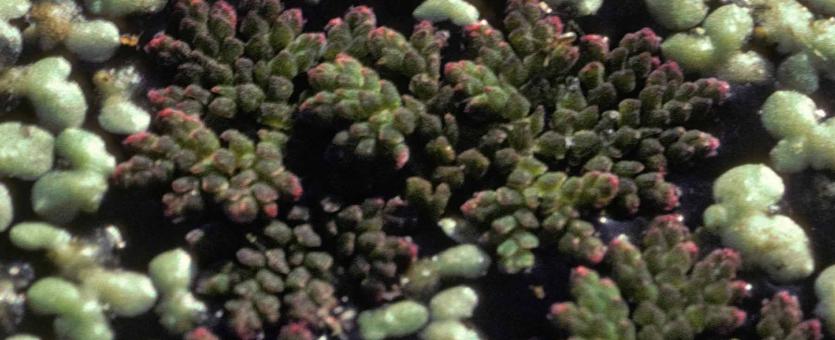
Water ferns float in velvety green or purplish-red masses on the water surface. Each mass is composed of many tiny fern plants, each smaller than a dime, but consisting of many small, overlapping leaves arranged around a central stalk, with a single rootlet dangling from the plant base.
Each leaf is 2-lobed. The floating lobe is smaller, green with chlorophyll (turning dark red later in the season), lacking venation, often with a nubby texture. The submerged lobe is larger, clear to translucent, lacking chlorophyll, and repels water, helping the plant to float. Ball-shaped, spore-producing structures are attached at the base of the submerged leaf-lobe, usually in groups of 2–4. Most reproduction, however, is vegetative, by the plants breaking into pieces and being distributed elsewhere by waterfowl.
Similar species:
- Eastern mosquito fern (Azolla caroliniana), a close relative, occurs scattered in eastern Missouri, where a few, vegetative specimens have been collected floating on ponds or stranded on mud. Its plants are smaller, usually less than ⅜ inch long, and the tiny, floating leaf-lobes are smaller and smoother than those of A. mexicana and do not overlap each other so much.
- Duckweeds and watermeal (family Lemnaceae) are also small floating pond plants, but their oval or circular leaflike bodies are usually larger than those of mosquito ferns and are not connected in elongated, branching stems.
Plant length: approx. ¼–¾ inch (0.7–2.0 cm). Floating leaf-lobe length: approx. 0.02–0.03 inch (0.6–0.8 mm).
Scattered, mostly in counties bordering the Mississippi, Missouri, and St. Francis rivers.
Habitat and Conservation
Mosquito fern floats on the water in ponds, sloughs, swamps, ditches, marshes, and still backwaters of rivers and streams. You may also see it stranded on mud by receding waters. A pond covered with Azolla seems to have a severe algae problem. Huge floating mats of this plant can completely cover a pond with a velvety green or purplish-red carpet. In autumn, the overwintering bodies of mosquito fern fall to the bottom of the pond; they return to the surface in late spring and summer.
Status
Mosquito fern is a native Missouri fern, but it can be a nuisance aquatic plant. It can completely cover a pond, lagoon, or slow-moving river, and it should never be introduced from one location to another.
Life Cycle
Vegetative reproduction is most common in mosquito ferns, with side branches breaking off and forming new plants. As ferns, they do not flower or produce seeds. Instead, they have a two-part life cycle. Generally speaking the plants we see are called sporophytes, and they produce spores. The spores germinate to become gametophytes, which create eggs and sperm, which unite to become a new sporophyte.
But it’s more complicated than that. Mosquito ferns have what botanists have called an “extraordinarily complex” set of reproductive structures. Most peoples' eyes will glaze over at just the names of these structures: sporocarps, two kinds of spores (megaspores and microspores), plus massulae, sporangia, and glochidia. The gametophytes live within the walls of megaspores, which are rounded at the base and have a triangular cap with 3 saclike floats. Don't worry, we won't quiz you on any of this. You're doing well if you just remember the life cycle is "complicated"!
Human Connections
The name “mosquito fern” arose from the belief that populations can grow so densely on the water surface that mosquitoes are unable to breed. Mosquito fern species in Asia have been used for this purpose, but although it might make it more difficult for mosquito larvae to breathe, it does not completely suppress them.
Mosquito ferns can become overabundant and should not be introduced. In some areas of the southern United States, mosquito ferns have interfered with livestock watering, blocked pump inlets, and affected commercial fishing. Also, because it can fix atmospheric nitrogen, it can enrich the water and encourage overgrowth of algae.
Elsewhere, mosquito ferns of various species have a tremendous value in agriculture. Because water fern species can capture nitrogen from the air and convert it to a form plants can use for nutrition, and because it can grow so abundantly, some species of Azolla are cultured as a “green manure” in rice paddies in southeast Asia. The paddies are flooded and the mosquito ferns introduced. Then, the fast-growing, thick mat of mosquito ferns suppresses weeds, and when the mosquito ferns rot, the nitrogen fertilizes the soil. In China, this practice has been used for more than 1,000 years.
The relatively high protein content of dried mosquito fern inspired feeding studies on using it as a component in commercial livestock feed.
Azolla plants are sometimes used in aquariums. However, it is not as commonly used as duckweed, hornwort, crystalwort (Riccia, a type of liverwort), and several other floating plants that require less light. Remember, never release aquarium plants, fish, or invertebrates into natural waters.
The complex reproductive biology and structures of mosquito ferns can seem either mind-numbingly tedious or intensely fascinating, depending on your perspective. Many people love solving riddles and learning about weird, offbeat, nerdy topics.
Ecosystem Connections
Mosquito ferns have chambers in the floating leaf lobes that contain a symbiotic blue-green alga (cyanobacterium), Anabaena azollae. This filamentous organism can fix nitrogen from the air into a nitrate form that can be used as a nutrient by the water fern. The blue-green alga benefits from the protective chamber in the fern, which also provides some mineral nutrients. This is similar to what happens in the roots of legume plants (peas, beans, clover, alfalfa, and so on).
About 49 million years ago, during the Eocene epoch and at a time when Earth’s atmosphere was about 41–46 F higher than it is today, tremendous mats of mosquito ferns apparently “bloomed” in the Arctic Ocean. When the plants sank to the bottom of the sea and were covered by sediment, they took with them large amounts of carbon dioxide, removing it from the global nutrient cycle. This contributed to the formation of Antarctic polar ice sheets and helped to cool the atmosphere to how it is today. Scientists call this the “Azolla event.”
In addition to research on Earth’s climate, there is also currently a lot of interest in exploring the Arctic for oil deposits. Much of this centers around the ancient, buried, fossilized Azolla beds. Burning this petroleum for energy would release the carbon — that the Azolla mats had sequestered millions of years ago — back into the atmosphere.

